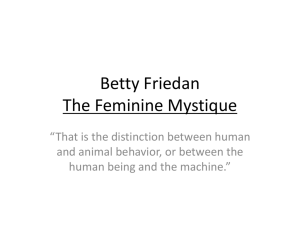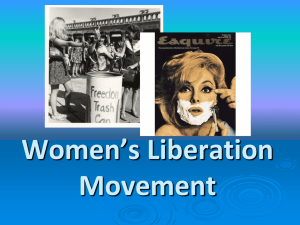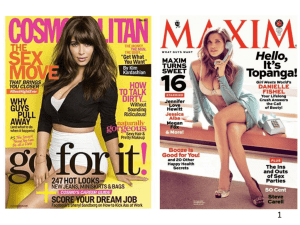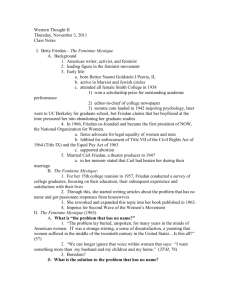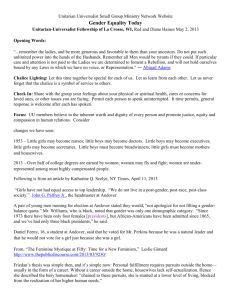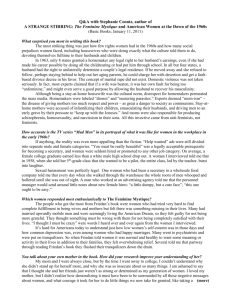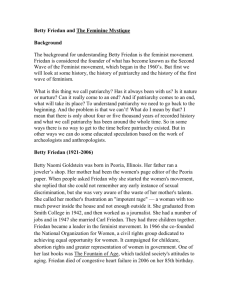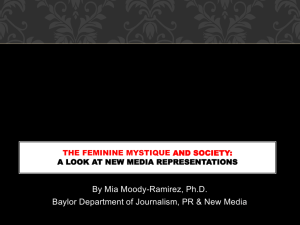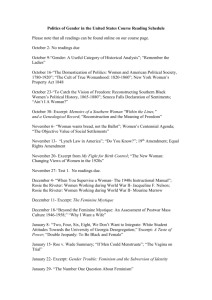Betty Friedan (b. 1921)
advertisement
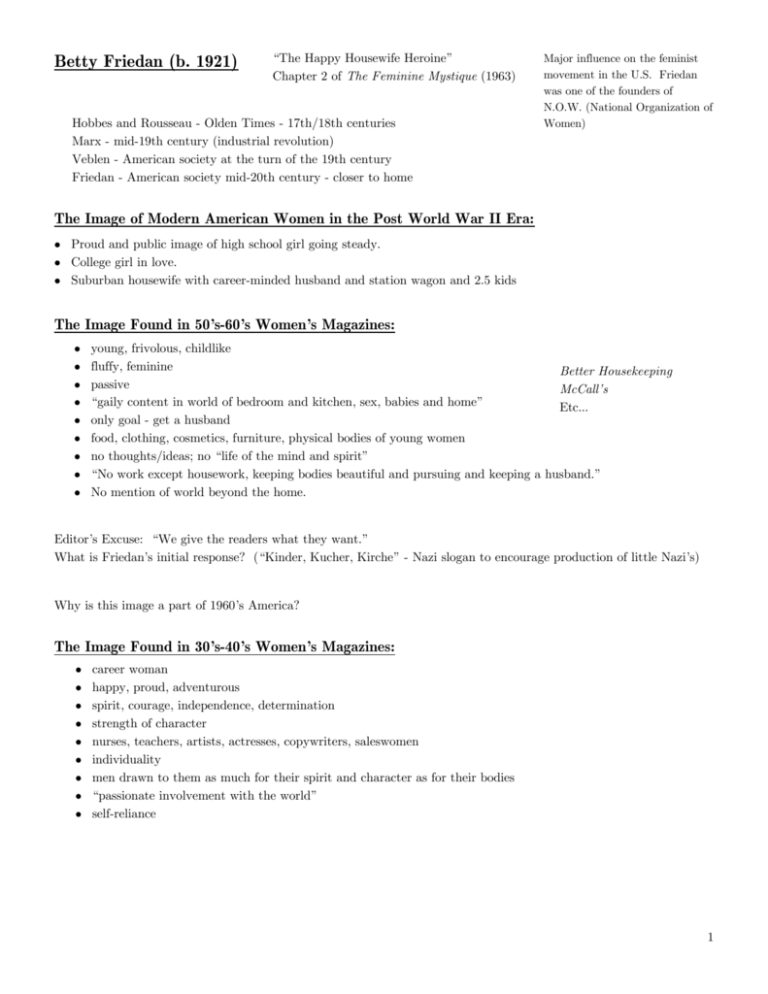
Betty Friedan (b. 1921) “The Happy Housewife Heroine” Chapter 2 of The Feminine Mystique (1963) Hobbes and Rousseau - Olden Times - 17th/18th centuries Marx - mid-19th century (industrial revolution) Veblen - American society at the turn of the 19th century Friedan - American society mid-20th century - closer to home Major influence on the feminist movement in the U.S. Friedan was one of the founders of N.O.W. (National Organization of Women) The Image of Modern American Women in the Post World War II Era: • Proud and public image of high school girl going steady. • College girl in love. • Suburban housewife with career-minded husband and station wagon and 2.5 kids The Image Found in 50’s-60’s Women’s Magazines: • • • • • • • • • young, frivolous, childlike fluffy, feminine Better Housekeeping passive McCall’s “gaily content in world of bedroom and kitchen, sex, babies and home” Etc... only goal - get a husband food, clothing, cosmetics, furniture, physical bodies of young women no thoughts/ideas; no “life of the mind and spirit” “No work except housework, keeping bodies beautiful and pursuing and keeping a husband.” No mention of world beyond the home. Editor’s Excuse: “We give the readers what they want.” What is Friedan’s initial response? (“Kinder, Kucher, Kirche” - Nazi slogan to encourage production of little Nazi’s) Why is this image a part of 1960’s America? The Image Found in 30’s-40’s Women’s Magazines: • • • • • • • • • career woman happy, proud, adventurous spirit, courage, independence, determination strength of character nurses, teachers, artists, actresses, copywriters, saleswomen individuality men drawn to them as much for their spirit and character as for their bodies “passionate involvement with the world” self-reliance 1 Moral in 1939: “If she kept her commitment to herself, she did not lose the man if he was the right man.” Friedan’s Caution: Of course these stories are not great literature and were not written for career women - they reflect the attitudes of 1930’s (pre-50’s decades) housewives. What caused the change in the image? How is the 50’s/60’s image perpetuated? Friedan’s Answer: Change is due to the rise of the “feminine mystique”: The Value System of the Feminine Mystique (1) Highest value and the only commitment for women is the fulfillment of their own femininity. (2) Femininity is different from masculinity, but not inferior; perhaps even superior. (3) Women are mistaken when they envy and emulate men. They must accept their own nature. (4) Nature of women: sexual passivity; male dominance; nurturing maternal love. (5) Occupation Housewife is a noble role. Major characteristic of Mystique Natural Woman - Housewife Unnatural Woman - Career Woman (masculine, unfeminine). “New Feminine Morality Story” Active “exorcising of the forbidden career dream” Step 1 Devil as career woman out to take heroine’s husband and child. Step 2 Devil inside heroine as dream of career, independence, community interests, international affairs (masculine tendencies). Step 3 Devil inside heroine as mind of her own. Step 4 “Togetherness”. Disappearance of heroine altogether as a separate self. Woman exists only for and through her husband and children. (Keep this in mind for later readings on fascism.) “Togetherness” - 1954 McCall’s. Family as a spiritual unit with all sharing in domestic chores. Criticism at the time: Why should men have to do women’s work? Friedan: Brought men into house without allowing women to leave it. Women are “...swallowed in an image of such passive dependence that they want men to make all the decisions, even in the home.” (pg. 87) Recall Rousseau: dependence is a necessary condition for oppression. For Friedan, “togetherness” is the height of oppression for women. 2 By the 50’s, the Feminine Mystique is firmly in place: “Women can’t take an issue pure - it has to be translated into terms they can understand as women.” “How to Have a Baby in an Atom Bomb Shelter” Friedan’s Reaction to Mystique The Mystique is a moral code used to enforce the 50’s/60’s housewife image. Masculine characteristics aren’t just unwomanly; they are downright immoral. Recall Rousseau’s Initiative #1 of the Rich - morality is introduced into society in order to protect the interests of a particular group. Friedan’s position: The Feminine Mystique is harmful - it does not express a fundamental truth. Women are the equals of men with the same “limitless [human] potential”. The 50’s/60’s image alienates women from this potential. Moreover, it serves as a basis on which preferential treatment for one segment of society (men) can be justified; i.e., it can be used to justify workplace discrimination against women. The Sphere of Moral Concern One way to provide a basis for discrimination is to attempt to ground a distinction between oppressor and oppressed. If there is a fundamental difference in the natures of two groups, this difference can be used to define the extent of the sphere of moral concern of one of them. Ex. “We don’t need to be concerned about equal opportunity in the workplace for women because it’s against their nature to work (they are fundamentally different, in this respect, from men).” Alternative Reaction We can agree with the basic claim of the Mystique, that women are fundamentally different from men, but define this difference in a different manner. Carol Gilligan In a Different Voice (1983) Psychological studies indicate a fundamental difference between young girls and boys. They act differently, have different moral standards. This should be encouraged - get more women into decision-making positions since they are better at negotiating, more even-handed, etc. Stronger position: Sandra Harding The Science Question in Feminism (1986), Whose Science? Whose Knowledge? (1991) Feminist standpoint epistemology: Women view the world differently. Because of their minority status, their way is to be preferred - less infected with established ways of thinking. 3 Question: When does a difference make a difference? Recall Hobbes and Rousseau - All humans (males and females) are fundamentally equal in both mental and physical attributes. Any individual differences can always be compensated for. What might this entail about such issues as women in the military? Rousseau: Moral (i.e., social) inequalities arise only with the rise of society. Male roles diverge from female roles at the Hut Stage of development. How do you think Rousseau would view the Feminine Mystique? Origin of the Mystique Friedan thinks the values of the Mystique might have been of practical use in the pre-modern period (the early pioneers, etc) when women had few opportunities and housekeeping/family-rearing “skills” were essential survival skills; but even then women played an active role in society. So the Mystique of the 50’s/60’s is doubly puzzling: Puzzling in its passivity, and puzzling in the fact that the women of the 50’s/60’s have more opportunities than their pioneer counterparts. Aside: Veblen thinks that the pecuniary struggle is based on that fundamental distinction between worthy work and unworthy work. And this distinction ultimately derives from the historical distinction between male roles and female roles. Does this count as an explanation of the origin of the mystique? The Mystique as a Media-Based, Self-Fulfilling Prophecy To what extent are your beliefs your own, and to what extent are they the media’s? Friedan: Give people an informed choice and then let them decide what to believe. When there is no informed choice, there is no freedom of belief. Claim: The 50’s/60’s image of the Housewife is the media’s, and not women’s. Evidence: 1. 30’s/40’s image. 2. 30’s/40’s articles about international affairs vs 50’s/60’s “service” articles (“How to Have a Baby in an Atom Bomb Shelter”). 3. Correlation between readers and subjects of stories. A 1960 survey indicated that women under 35 identified with victims and not with agents - no self-determination. 4. Documented sense of alienation felt by many housewives of the time. 5. Drop in readership in direct proportion to increasing “mindlessness” of image. One possible explanation for the rise of the Mystique 30’s/40’s image was created by women writers and editors. The 50’s image was created by men. Large number of men enter the workplace after World War II; women drop out to raise kids (Baby Boom). 4
